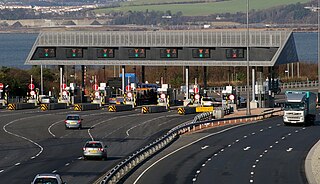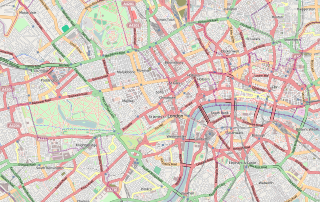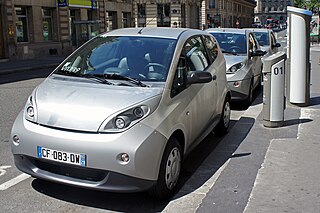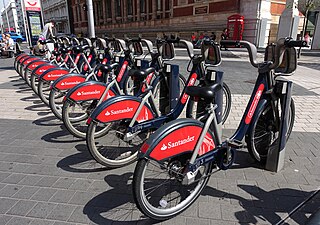Related Research Articles

The mayor of London is the chief executive of the Greater London Authority. The role was created in 2000 after the Greater London devolution referendum in 1998, and was the first directly elected mayor in the United Kingdom.

The City of Westminster is a city and borough in London. It is the site of the United Kingdom's Houses of Parliament and much of the British government. It occupies a large area of central London, including most of the West End. Many London landmarks are within the borough, including Buckingham Palace, Westminster Abbey, Whitehall, Westminster Cathedral, 10 Downing Street, and Trafalgar Square.

Wandsworth is a London borough in South West London, England. It forms part of Inner London and has an estimated population of 329,677 inhabitants. Its main named areas are Battersea, Balham, Putney, Tooting and Wandsworth Town.

The London congestion charge is a fee charged on most cars and motor vehicles being driven within the Congestion Charge Zone (CCZ) in Central London between 7:00 am and 6:00 pm Monday to Friday, and between 12:00 noon and 6:00 pm Saturday and Sunday.

Road pricing are direct charges levied for the use of roads, including road tolls, distance or time-based fees, congestion charges and charges designed to discourage the use of certain classes of vehicle, fuel sources or more polluting vehicles. These charges may be used primarily for revenue generation, usually for road infrastructure financing, or as a transportation demand management tool to reduce peak hour travel and the associated traffic congestion or other social and environmental negative externalities associated with road travel such as air pollution, greenhouse gas emissions, visual intrusion, noise pollution and road traffic collisions.

Central London is the innermost part of London, in England, spanning the City of London and several boroughs. Over time, a number of definitions have been used to define the scope of Central London for statistics, urban planning and local government. Its characteristics are understood to include a high-density built environment, high land values, an elevated daytime population and a concentration of regionally, nationally and internationally significant organisations and facilities.
There have been two separate generations of trams in London, from 1860 to 1952 and from 2000 to the present. There were no trams at all in London between 1952 and 2000.

The Bolloré Bluecar is a small four-seat, three-door electric car supplied by Bolloré, designed by Pininfarina and manufactured by Cecomp in Bairo, Italy, under a joint venture owned by Bolloré and Pininfarina called Véhicule Électriques Pininfarina Bolloré (VEPB). The car has a 30kWh lithium metal polymer (LMP) battery, coupled to a supercapacitor, that provides an electric range of 250 km (160 mi) in urban use, and a maximum speed of 120 km/h (75 mph).
The Ier is a river in Romania and Hungary.

Bolloré SE is a French conglomerate headquartered in Puteaux, on the western outskirts of Paris, France. Founded in 1822, the company has interests in Vivendi, international freight forwarding, oil storage and pipelines in France, solid state batteries, access control systems for buildings, palm oil and rubber in Asia and Africa, olive groves in the US and wine production in France.

The London Low Emission Zone (LEZ) is an area of London in which an emissions standard based charge is applied to non-compliant commercial vehicles. Its aim is to reduce the exhaust emissions of diesel-powered vehicles in London. This scheme should not be confused with the Ultra Low Emission Zone (ULEZ), introduced in April 2019, which applies to all vehicles. Vehicles that do not conform to various emission standards are charged; the others may enter the controlled zone free of charge. The low emission zone started operating on 4 February 2008 with phased introduction of an increasingly stricter regime until 3 January 2012. The scheme is administered by the Transport for London executive agency within the Greater London Authority.

An electric vehicle charging network is an infrastructure system of charging stations to recharge electric vehicles. The term electric vehicle infrastructure (EVI) may refer to charging stations in general or the network of charging stations across a nation or region. The proliferation of charging stations can be driven by charging station providers or government investment, and is a key influence on consumer behaviour in the transition from internal combustion engine vehicles to electric vehicles. While charging network vendors have in the past offered proprietary solutions limited to specific manufacturers, vendors now usually supply energy to electric vehicles regardless of manufacturer.
ChargePoint is an American electric vehicle infrastructure company based in Campbell, California. ChargePoint operates the largest online network of independently owned EV charging stations operating in 14 countries and makes some of its technology.

Santander Cycles is a public bicycle hire scheme in London in the United Kingdom. The scheme's bicycles are popularly and colloquially known as Boris Bikes, after Boris Johnson who was Mayor of London when the scheme began operating.

Autolib' was an electric car sharing service which was inaugurated in Paris, France, in December 2011. It closed on 31 July 2018. It was operated by the Bolloré industry and complemented the city's bike sharing system, Velib', which was set up in 2007. The Autolib' service maintained a fleet of all-electric Bolloré Bluecars for public use on a paid subscription basis, employing a citywide network of parking and charging stations. As of 3 July 2016, 3,980 Bluecars had been registered for the service and had more than 126,900 registered subscribers; Autolib' furthermore offered 1,084 electric car stations in Paris agglomeration with 5,935 charging points.

The adoption of plug-in electric vehicles in the United Kingdom is actively supported by the British government through the plug-in car and van grants schemes and other incentives. About 745,000 light-duty plug-in electric vehicles had been registered in the UK up until December 2021, consisting of 395,000 all-electric vehicles and 350,000 plug-in hybrids. Until 2019, the UK had the second largest European stock of light-duty plug-in vehicles in use after Norway.
The electric vehicle industry in India is slowly growing. The central and state governments have implemented schemes and incentives to promote electric mobility, and have introduced regulations and standards.
Chargemaster Limited is a supplier of charging infrastructure for electric vehicles, based in Milton Keynes, England. It provides charging units for home, business and public use, and operates its own electric vehicle public charging network, which is the largest network in the United Kingdom.

Pod Point is a UK provider of electric vehicle charging station. It provides charging units for home, business and public use. Since forming in 2009, Pod Point has manufactured and sold over 220,000 charging points. It has also developed one of the UK's largest public networks, connecting EV drivers with charging stations nationwide at locations such as Tesco, Lidl, Sainsbury's, Center Parcs and Southern Rail. Since 2014, when it signed a partnership with automaker Nissan, it also operates in Norway.

BlueSG is a Singaporean company providing electric car sharing and electric car charging services. Announced in September 2017, the company, a subsidiary of Goldbell, launched the service in December of the same year, with 30 charging stations and 80 all-electric Bolloré Bluecar for public use on a paid subscription basis.
References
- ↑ "Source London web site, Membership details" . Retrieved 9 April 2013.
- 1 2 3 "Mayor switches on new electric vehicle scheme 'Source London'". Transport for London. 27 May 2011. Retrieved 27 May 2011.
- ↑ "Mayor's electric vehicle charging network, Source London, to go live in spring 2011". Transport for London. 6 November 2010. Retrieved 27 May 2011.
- ↑ "Mayor switches on new electric vehicle scheme - Source London". Source London. Retrieved 27 May 2011.
- ↑ "About Source London". Source London. 30 November 2018. Retrieved 13 April 2019.
- ↑ "Greater London Authority Group". Source London. Retrieved 27 May 2011.
- ↑ "Source London website" . Retrieved 17 February 2015.
- ↑ "Twitter status update after IER takeover" . Retrieved 17 February 2015.
- ↑ ""Companies House notification"" . Retrieved 1 October 2021.
- ↑ "London Local Authorities". Source London. Retrieved 27 May 2011.
- ↑ "The charge point network for London". Source London. Retrieved 27 May 2011.
- ↑ "A plan for London". Source London. Retrieved 27 May 2011.
- ↑ "London's electric car infrastructure falling into ruin", The Telegraph, 24 October 2014. Accessed 15 October 2015
- ↑ "BluePointLondon to manage charging points in Kensington and Chelsea, Hackney and Greenwich". 20 May 2015. Retrieved 22 April 2016.
- ↑ "Wandsworth Council presses ahead with EV charging infrastructure".